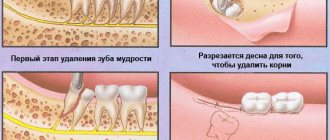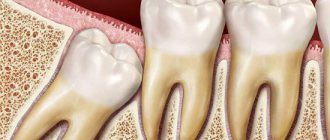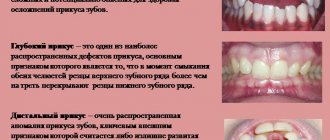Wisdom or 8 teeth can cause a lot of problems, especially if they grow into the cheek. These teeth have no analogues in the primary occlusion, so they erupt through unprepared periodontal tissue, and their growth is accompanied by discomfort even with proper eruption. The growth of eighth teeth can begin at age 17, but there are cases when these teeth remain impacted (not erupted) throughout life.
Symptoms and signs of abnormal growth
It is extremely rare for eights to appear without any complications. This is due, first of all, to the fact that wisdom teeth grow in adulthood, when the jaw is already formed. Even with proper teething, discomfort may still be present for several weeks or months. If a wisdom tooth grows incorrectly or has an abnormal location, then certain symptoms indicate this.
Let's take a closer look at the types of pathologies and symptoms associated with the growth of wisdom teeth.
- Retention is a pathology in which the third molar is located under the mucous or bone tissue. The main symptoms are severe pain in the gums, as well as the development of an inflammatory process in the gum pocket.
- Dystopia or abnormal position of the tooth. It manifests itself as severe pain, affecting adjacent teeth, and the development of inflammation, including phlegmon or osteomyelitis.
The initial alarming symptoms that a patient may identify when a wisdom tooth grows are:
- Swelling in the cheek area.
- When swallowing, severe pain occurs, radiating to the throat or ear.
- Purulent or bloody discharge.
- Injury to the mucous membrane.
If you detect at least one of the above symptoms during the eruption of figure eights, you must seek the help of a dentist as soon as possible. The doctor will conduct an x-ray and determine whether the wisdom tooth is growing correctly.
Other causes of pain during the eruption of wisdom teeth
Only in rare cases do eights erupt without problems, but more often this happens for a long time and painfully. Severe pain also appears if:
- the tooth is cut through already formed bone;
- growth does not occur upward, but to the side at an angle, while it rests on adjacent teeth or jawbone;
- there is not enough space in the mouth for a figure eight to fully grow;
- inflammation began in the soft tissues around the tooth;
- an infection has entered the canal;
- the presence of a carious cavity in the figure eight, which often grows very slowly.
What to do with a bothersome wisdom tooth at home
The most important thing is not to cause further harm to yourself before visiting the dentist. It is extremely important to avoid overheating the area of concern. Heat can accelerate the onset of the inflammatory process. Therefore, you should not apply warm compresses or take a hot bath.
What can you do to relieve pain when wisdom teeth erupt:
- follow a gentle diet (do not eat very hard, hot or cold foods);
- after eating, rinse your mouth;
- use local anesthesia, such as gels used during teething in children;
- In case of severe pain, you can take painkillers.
But the most important thing is not to delay your visit to a specialist! Only he will be able to determine the seriousness of the problem and help avoid possible complications.
Pain and inflammation of the gums above the wisdom tooth -
In this section we will tell you what to do when your wisdom tooth comes out and your gums hurt. As we said above, pain can be associated either with inflammation of the gums above the erupting tooth, or with displacement of the teeth. In the latter case, this is similar to the movement of teeth through the use of braces (only in this case, the movement of teeth will be provoked not by a metal arch, but by an erupting wisdom tooth). The first thing you should do is look into your mouth and assess the situation.
Inflammation of the gums above the wisdom tooth occurs when one part of the crown has already erupted, and the second is still covered with mucous membrane (Fig. 2). That part of the gum mucosa that hangs over the crown of the eighth tooth is what dentists call the “hood.” Food debris and microbial plaque usually accumulate in this place, which leads to inflammation of the mucous membrane and pain.
In addition to pain, the presence of inflammation of the gums above the wisdom tooth is usually indicated by: 1) redness and swelling of the gums, 2) suppuration from under the hood, but sometimes pus can only be released when pressing on it, 3) bad breath, 4) less often may be fever, painful swallowing or difficulty opening the mouth, as well as swelling of the cheek. The presence of symptoms from the last point indicates an unfavorable course of inflammation. Dentists call inflammation of the hood over a wisdom tooth “pericoronitis.”
Eruption of wisdom teeth and “pericoronitis” –
A wisdom tooth is coming out, your gums hurt: what to do if the hood is small and covers only a small part of the crown of the wisdom tooth, and there is no active inflammation (suppuration, painful swallowing, etc.) - antiseptic rinses with Chlorhexidine solution and applications of the anti-inflammatory gel Cholisal can help. In case of severe pain, it is advisable to simultaneously take analgesics from the NSAID group, for example, ibuprofen. These drugs have not only analgesic, but also a pronounced anti-inflammatory effect.
But in all other cases, a minor surgical intervention will be necessary - excision of the hood. The operation is low-traumatic and takes only a few minutes. Its goal is to remove the area of the gum mucosa that hangs over the crown of the tooth. In some cases (when the doctor sees that in any case there is not enough space for the tooth to erupt, which means excision of the hood will only give a temporary effect), the dental surgeon decides to remove the wisdom tooth.
Pericoronitis and laser excision of the hood: video 1-2
Local anti-inflammatory therapy –
- antiseptic rinses with 0.05% Chlorhexidine solution,
- applications with Cholisal-gel.
Treatment of inflamed gums is carried out 2-3 times a day - in the morning after breakfast and brushing your teeth, in the evening (before bed) after brushing your teeth, and also in the middle of the day. Each time, you first need to rinse your mouth with Chlorhexidine for 1 minute - then dry the gums with a dry gauze swab and apply the gel to the surface of the hood using your finger. Afterwards, you should not rinse your mouth or eat food for 2-3 hours. By the way, Cholisal gel, in addition to a pronounced anti-inflammatory effect, also has an analgesic effect.
Removal of abnormally growing eighth tooth
Very often, if the third molar grows abnormally, it is necessary to resort to its removal. Indications for surgery:
- Repeated cases of pericoronitis (purulent formation in the gum pocket). This problem most often occurs on the lower eights, which have not completely erupted. Pericoronitis is usually treated by removing the overhanging gum, but if the disease recurs, it is recommended to remove the offending tooth.
- The upper eight grows into the cheek, constantly injuring it. To avoid the formation of ulcers and infection of the oral cavity, as well as to prevent pain, wisdom tooth removal is required.
- The development of wisdom tooth dystopia was diagnosed. The tooth grows at an incorrect angle, which can lead to inflammation of the periodontal tissues and the development of caries on the eighth and neighboring teeth.
- The wisdom tooth grows to the side and affects the ternary nerve, causing attacks of pain. Most often, this occurs when an unerupted figure eight rests on the roots of neighboring teeth. Such an anomaly can only be diagnosed using an x-ray.
The procedure for performing the manipulation may differ depending on the location of the tooth. The sequence of the procedure during surgery:
- antiseptic treatment of the operating area;
- administration of anesthetic;
- tooth extraction;
- inserting a gauze swab into the hole to eliminate bleeding.
The tampon should be removed from the wound no earlier than after 25 minutes. The tampon must be in the socket to prevent bleeding. After the operation, the dental surgeon gives recommendations that must be strictly followed.
What problems may arise in the growth of eights?
- A wisdom tooth may not fully erupt if there is not enough space in the row - such elements are called impacted (fully or partially). The interesting thing is that the figure eight can even look like a full-fledged tooth, but remain inside the bone tissue. Its position can be absolutely anything - vertical, horizontal (rests against the root of its neighbor) or even inverted. In this case, the root system will be near the gums, and the chewing surface, on the contrary, will be below,
- violation of the position, i.e. crooked tooth - in this case it is usually called dystopic,
- if the figure eights are only partially cut through, then a kind of “hood” is formed above them, into which food particles fall. As a result, redness, swelling and acute inflammation of the gums develop, which is accompanied by pain, unpleasant odor,
- the risk of developing caries and gum disease in the area of wisdom teeth is much higher, since hygiene procedures are difficult - that is, the figure eight can erupt immediately with caries.
Important! There is absolutely no need to remove wisdom teeth if they have grown evenly, do not cause pain or displacement of their neighbors, and also in cases where the doctor can reach them if treatment of caries or even pulpitis is required.
Thus, if the eights grow with disturbances, then they lead to bite pathologies, displacement of other teeth, tissue inflammation and very difficult oral hygiene.
Is it possible to straighten crooked teeth as an adult?
Dentistry today offers many ways to correct malocclusion in adults. When a person, year after year, day after day, sees in the reflection a smile with uneven teeth, it will be very interesting for him to look at the prospect, to see how his smile will look with a corrected bite. It will be interesting to know how this will affect the external image. Finding out this became possible with the 3D virtual setup technique, when the patient can see the step-by-step change in the position of his teeth.
The technique of correcting a bite with aligners involves preliminary drawing up a virtual treatment plan. The dentist takes photographs of the patient: his face, teeth. X-rays and dental impressions are taken. The data is processed by a computer program, resulting in a three-dimensional model in which the simulated dentofacial system is visible from all sides.
The orthodontist has been trained in imaging software and can create a treatment plan by moving the curved units along the desired path to create an even row on the arch. The computer calculates the duration of treatment until the desired result is achieved, as well as the required number of droppers for therapy. The technique is almost 100% accurate. Computer modeling is programmed in such a way as to calculate all stages of change on the path to correcting the pathology.










